SEO
Payday loans algorithm update 2022

The payday loans algorithm continues to challenge search engine optimization (SEO) practitioners across the world, notably in the US and UK – the two largest markets for payday loans.
In 2012, UK’s payday loan market was worth around £2 billion and was so sought after that Google’s entire first page for payday loans was dominated by black hat results.
In response, the tech giant created a dedicated algorithm – which was revised in 2018 – known today as ‘payday loans 2.0’. The purpose of the algoritm was target what Google deemed “spammy queries”; never before had Google devoted an entire algorithm for one particular product or service.
The payday loan market in the UK is now heavily regulated and no longer as lucrative. But SEO professionals looking to help promote payday loan companies are still hoping to land on a search engine’s first page in order to access very high converting products with over 100,000 monthly searches.
Drawing on Tudor Lodge’s findings from the 2019 and 2021 algorithm, we look at how the payday algorithm has developed in the UK and US, and what techniques are succeeding in 2022.
Frequency of updates
Payday loan companies looking to rank their sites higher on search engines may fine they are struggling to make progress, even with the help of SEO practitioners. When this progress will appear, may also seem uncertain.
In the UK, Google infrequently updates its SEO algorithm which means a company with ‘good’ SEO could result in it ranking highlight for months or even a year, without having to change very much. This means companies can ‘ride the wave’ of their previous good SEO work.
There is an age-old SEO assumption that Google takes the techniques used by websites on page 1 of its search and uses these techniques as the basis for the algorithm. Therefore, companies which copy the links and style of content of page 1 should be successful.
In the US, however, the frequency of SEO changes for payday loans is significantly quicker, with the search results changing far more regularly and competitors having to be consistent to maintain those results.
This could reflect the more competitive environment in the US and how state-specific lenders, such as those from Florida or Ohio, might suddenly start to rank higher due to demand in those areas.
Role of exact match and partial match domains
Traditionally, having the word ‘payday’ in a business’ domain name was a strong ranking signal to secure a page 1 position, but this seems to be less relevant as time goes on.
Filtering by the UK’s geography, only one website appears on Google’s Page 1 search results page with the word payday in the businesses’ domain name; it is one of the oldest payday lenders in the market. The same occurs when filtering for the US market, only in this instance, the firm has used a black hat technique.
As a result, companies looking to set up a website in this market do not need to include the word ‘payday’ within their domain name to be successful.
Popular techniques and red flags
There are a couple of techniques, however, which will stand businesses looking to gain traction in the payday loan market in good stead.
- Careful phrasing is one of these techniques. Companies looking to improve their payday loan SEO should look carefully at the phrasing used by websites which rank on page 1 in the UK and US.
These websites tend to use the following terms: “direct lenders”, “bad credit”, and “alternatives”. Other popular phrases include payday loans online used by Dime Alley and include the word “instalment”.
Tudor Lodge’s previous investigation into the algorithm suggests these phrases push websites up the ranking because Google wants to: provide “alternatives” rather than expensive payday products; ensure “direct lenders” are promoted over brokers; and appeal to “bad credit” which is the real use of the product.
- Another technique to be considered is the use of Google Business, a free service which allows organizations to manage and optimize their businesses’ profile on Google. In recent years, the platform has gained more exposure in the SERPs for payday loans.
Arguably this is not surprising since figures show Google Business clicks are surpassing normal clicks on Google for the first time ever this year. This is particularly relevant in the US where there are over 23,000 payday stores and the role of local listings is far more important than in the UK where the industry is mainly online.
For SEO practitioners, having a populated Google Business account with images, descriptions and organic reviews will only help to secure more exposure and clicks, even for new entries.
And of course, making sure the address and contact details on your website are very clear on the footer and contact us page. Without any contact details or address on your website, you are pretty much a ghost in Google’s eyes.
- Another important detail for SEO practitioners and payday loan companies to think about is ensuring there is an explanation of how their product works. Customers need to know how to apply for a payday product listed on a website.
Websites listed on Page 1 of Google’s listings all ensure this copy is clear and concise, whether it be through a steps process – as demonstrated by Pheabs – or a dedicated ‘how it works’ page.
In addition to best practice, there are a number of techniques which are now grossly out of fashion.
- Long content and landing pages are one example. Whilst I personally have always been a fan of long content, and nice strong landing pages, there are several strong examples on Google’s Page 1 which seem to defy this.
These websites, some with limited content (but a strong backlink profile) and others just including a ‘how it works’ page and some strong FAQs on their homepages, have managed to maintain their top spots. This might suggest backlinks are stronger than content in this market.
- Another faux pas is having multiple pages on a payday website. It could be assumed that having pages dedicated to each product, service and question would help the consumer journey, the sites that have multiple pages have declined and been penalized in 2021. This suggests companies should approach their website through the lens of having one, focused page which discusses different locations on said.
Where do links fall into this algorithm?
Links are always so vital for SEO, and Tudor Lodge’s studies show that acquiring links is likely to make a company’s website rank quicker in in the payday market, than adding more content would.
The role of PBNs is still evident with SEO professionals buying links and this is having a positive correlation on rankings, unless hit with a penalty. Some of the best ranking sites can leverage links from ‘gov.uk’ and ‘.edu’ by offering sponsorships and associating with good causes.
Long SEO articles on third party sites
Finally, there has been a surge in the US of companies who are ranking third party articles, rather than individual sites.
The SEO professional is writing very long and detailed pieces about payday loans and including lots of relevant keywords such as “no credit check” and “bad credit” – then listing their 4 or 5 favourite sites or clients in the text to generate leads.
Using third party sites, often regional or state press sites with domain authorities of 80 or higher, ensures these articles rank well and gains instant exposure via Google News. This technique is often underrated by the industry but has gained a lot of visibility in recent years.
It is innovative and well executed and essentially just SEO by any other name.
Source link
SEO
Measuring Content Impact Across The Customer Journey
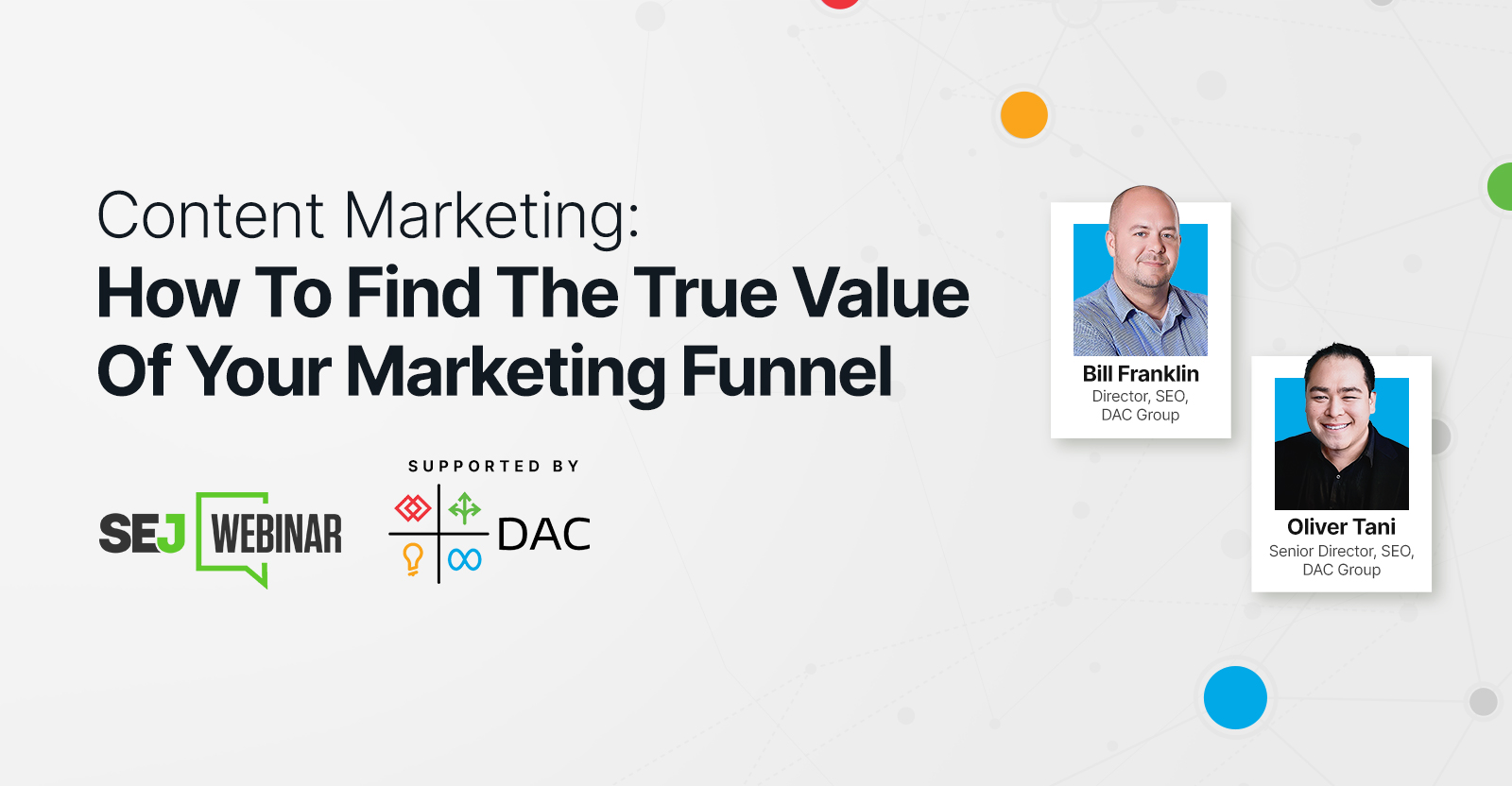
Understanding the impact of your content at every touchpoint of the customer journey is essential – but that’s easier said than done. From attracting potential leads to nurturing them into loyal customers, there are many touchpoints to look into.
So how do you identify and take advantage of these opportunities for growth?
Watch this on-demand webinar and learn a comprehensive approach for measuring the value of your content initiatives, so you can optimize resource allocation for maximum impact.
You’ll learn:
- Fresh methods for measuring your content’s impact.
- Fascinating insights using first-touch attribution, and how it differs from the usual last-touch perspective.
- Ways to persuade decision-makers to invest in more content by showcasing its value convincingly.
With Bill Franklin and Oliver Tani of DAC Group, we unravel the nuances of attribution modeling, emphasizing the significance of layering first-touch and last-touch attribution within your measurement strategy.
Check out these insights to help you craft compelling content tailored to each stage, using an approach rooted in first-hand experience to ensure your content resonates.
Whether you’re a seasoned marketer or new to content measurement, this webinar promises valuable insights and actionable tactics to elevate your SEO game and optimize your content initiatives for success.
View the slides below or check out the full webinar for all the details.
SEO
How to Find and Use Competitor Keywords
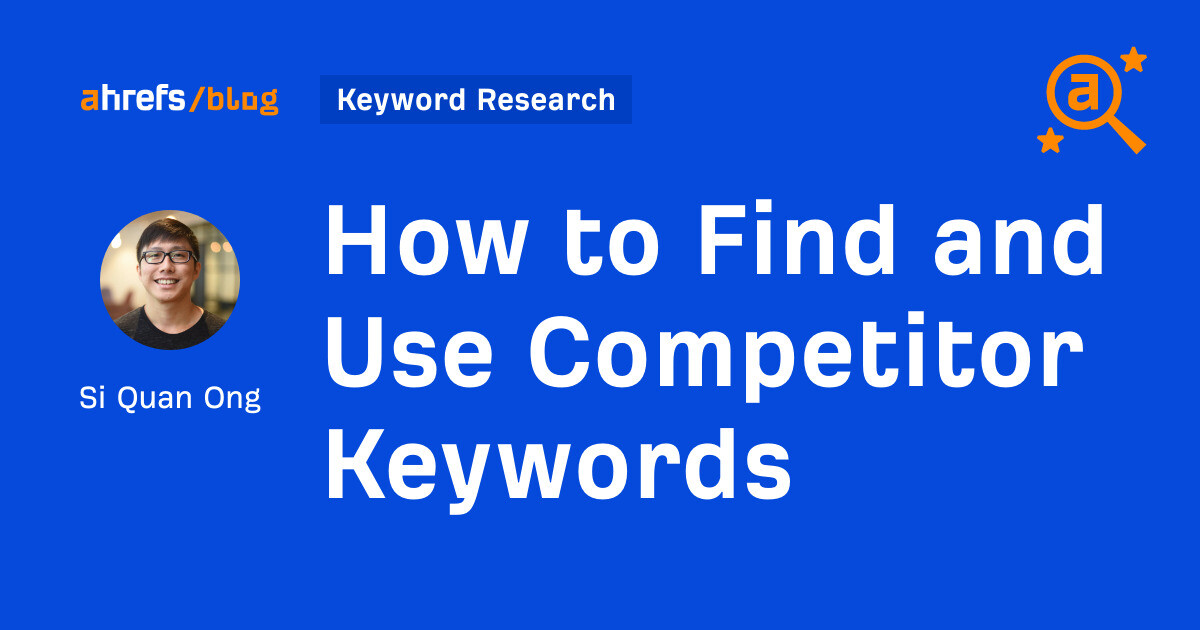
Competitor keywords are the keywords your rivals rank for in Google’s search results. They may rank organically or pay for Google Ads to rank in the paid results.
Knowing your competitors’ keywords is the easiest form of keyword research. If your competitors rank for or target particular keywords, it might be worth it for you to target them, too.
There is no way to see your competitors’ keywords without a tool like Ahrefs, which has a database of keywords and the sites that rank for them. As far as we know, Ahrefs has the biggest database of these keywords.
How to find all the keywords your competitor ranks for
- Go to Ahrefs’ Site Explorer
- Enter your competitor’s domain
- Go to the Organic keywords report
The report is sorted by traffic to show you the keywords sending your competitor the most visits. For example, Mailchimp gets most of its organic traffic from the keyword “mailchimp.”


Since you’re unlikely to rank for your competitor’s brand, you might want to exclude branded keywords from the report. You can do this by adding a Keyword > Doesn’t contain filter. In this example, we’ll filter out keywords containing “mailchimp” or any potential misspellings:
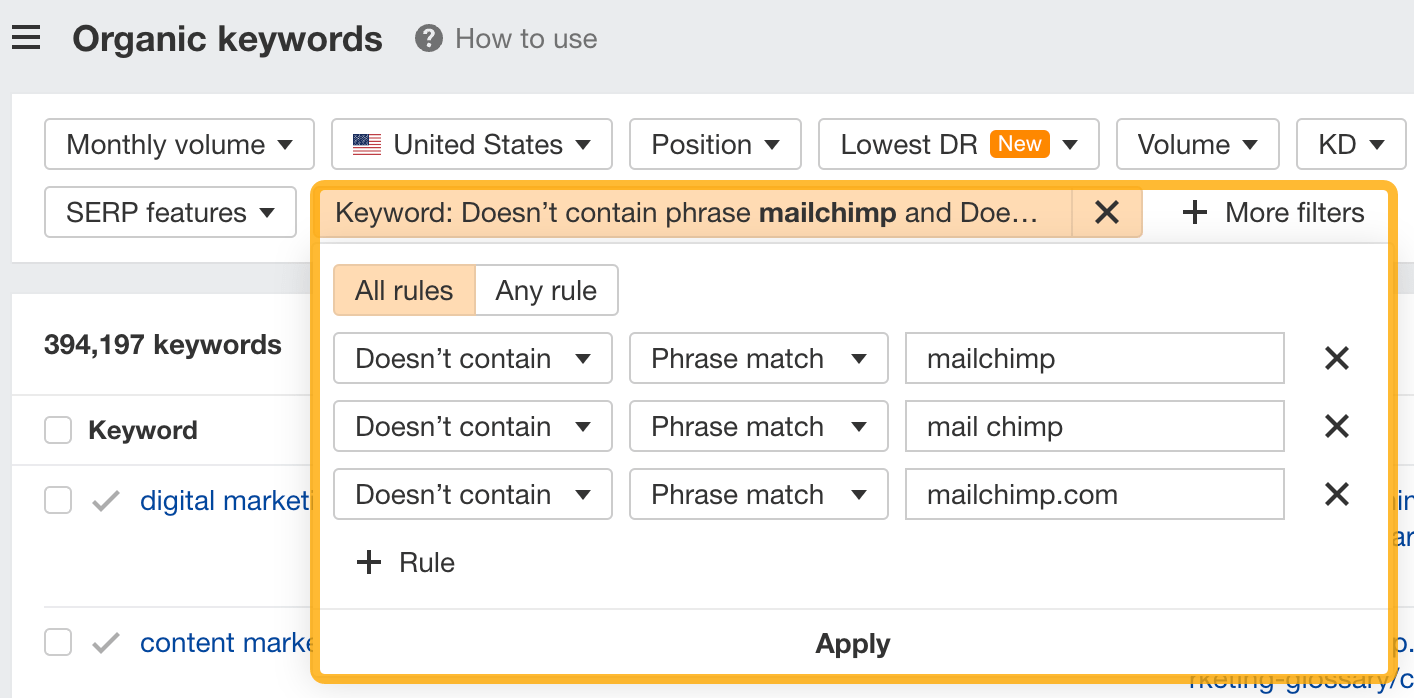

If you’re a new brand competing with one that’s established, you might also want to look for popular low-difficulty keywords. You can do this by setting the Volume filter to a minimum of 500 and the KD filter to a maximum of 10.
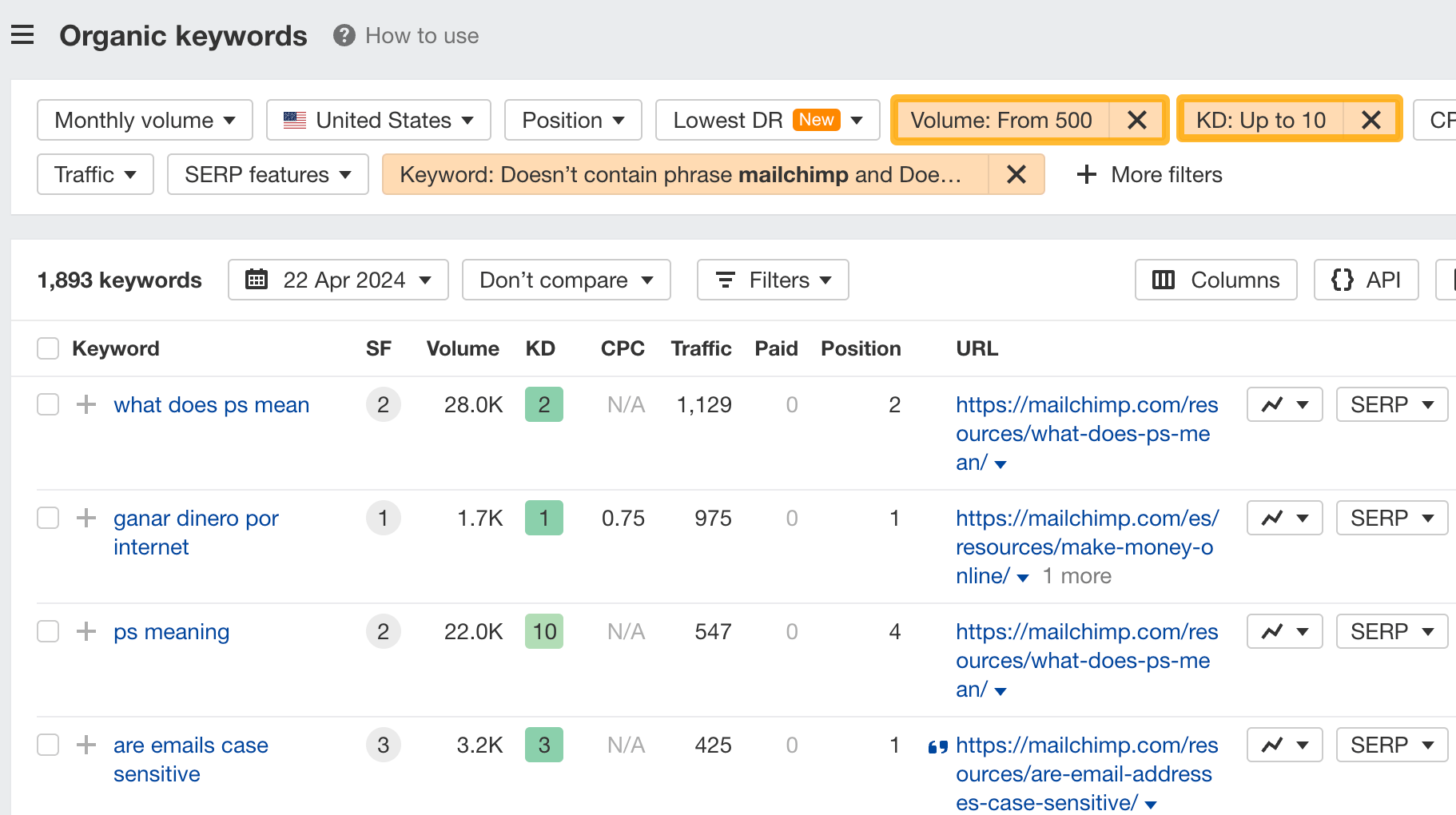

How to find keywords your competitor ranks for, but you don’t
- Go to Competitive Analysis
- Enter your domain in the This target doesn’t rank for section
- Enter your competitor’s domain in the But these competitors do section
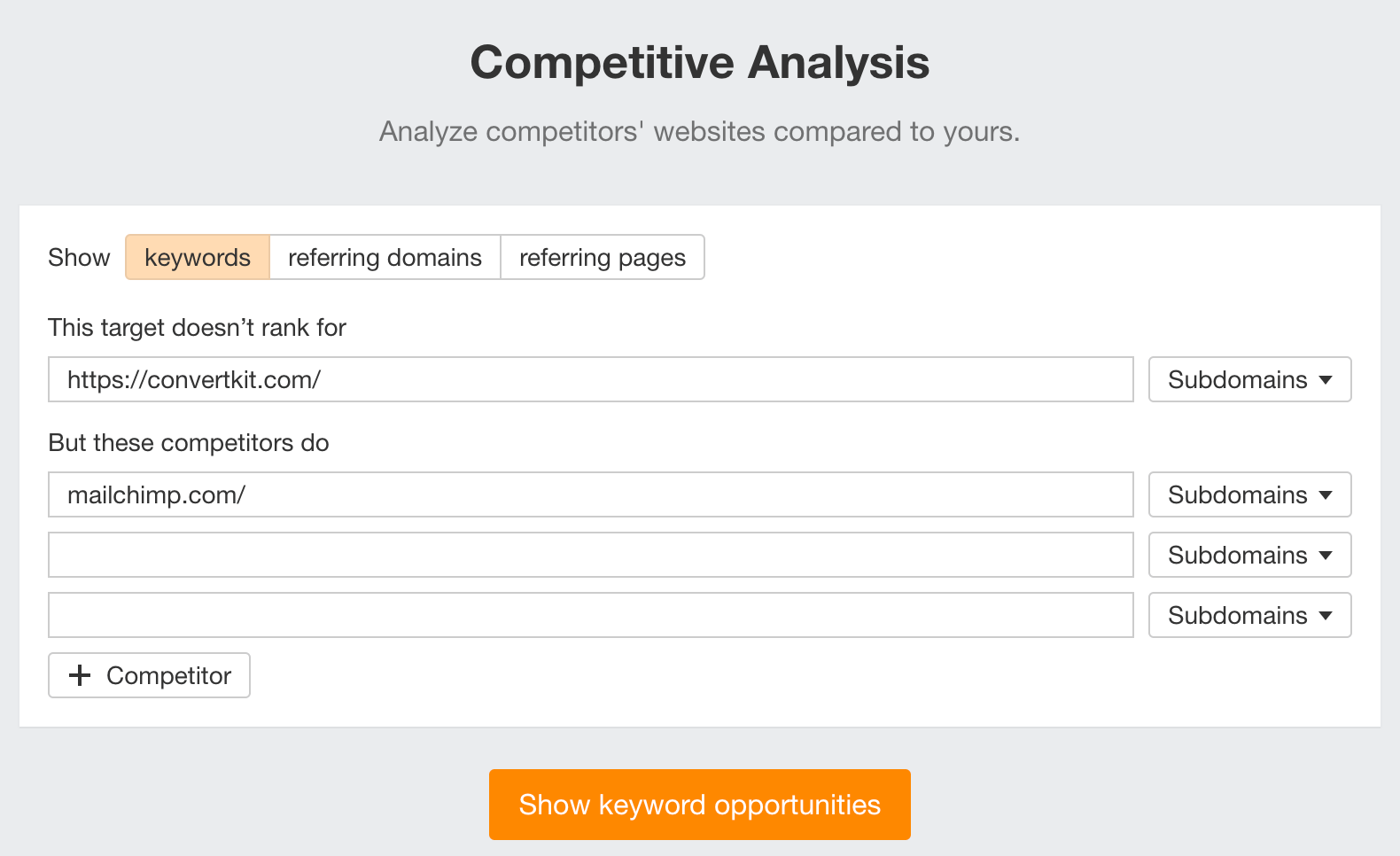

Hit “Show keyword opportunities,” and you’ll see all the keywords your competitor ranks for, but you don’t.
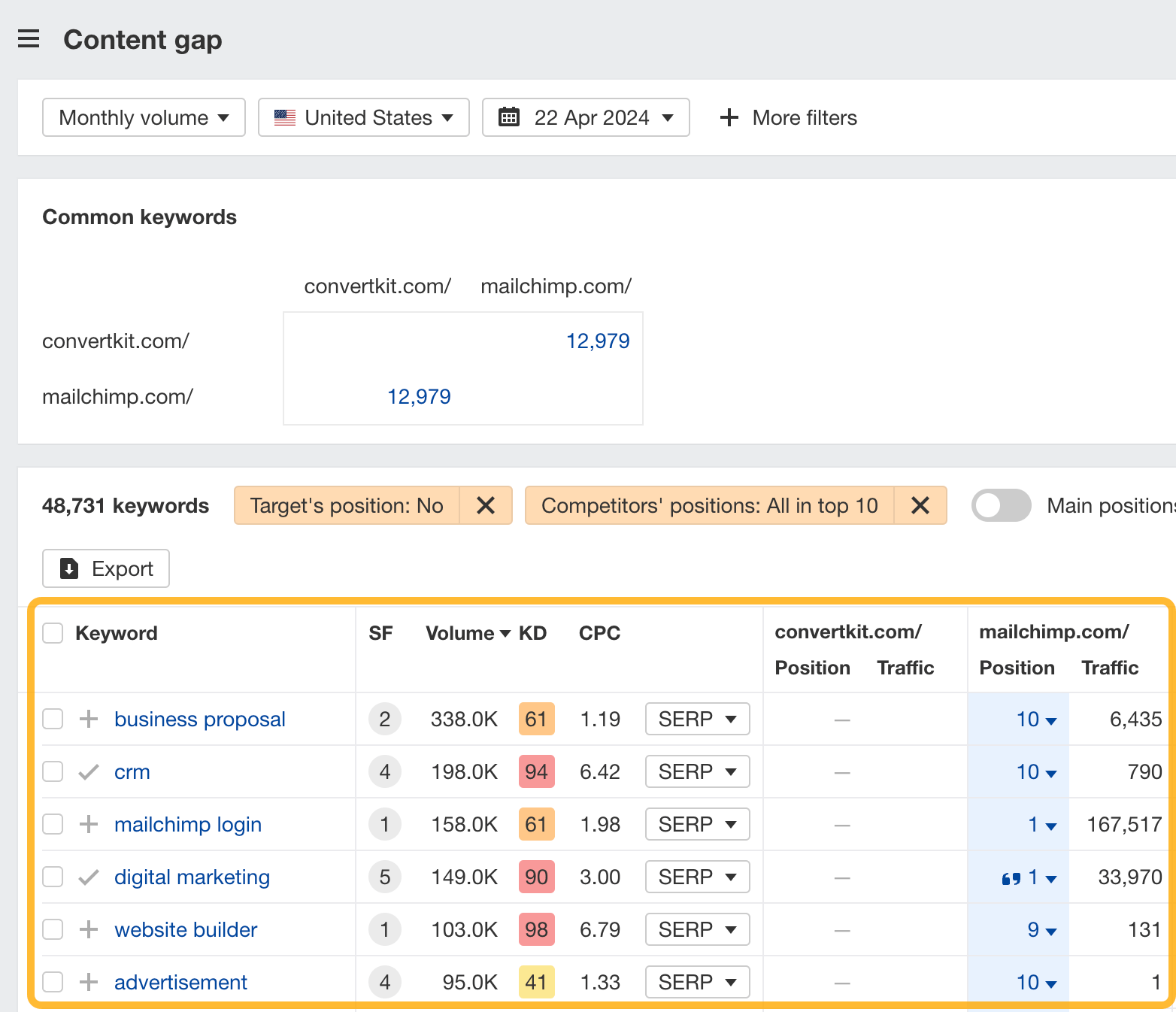

You can also add a Volume and KD filter to find popular, low-difficulty keywords in this report.
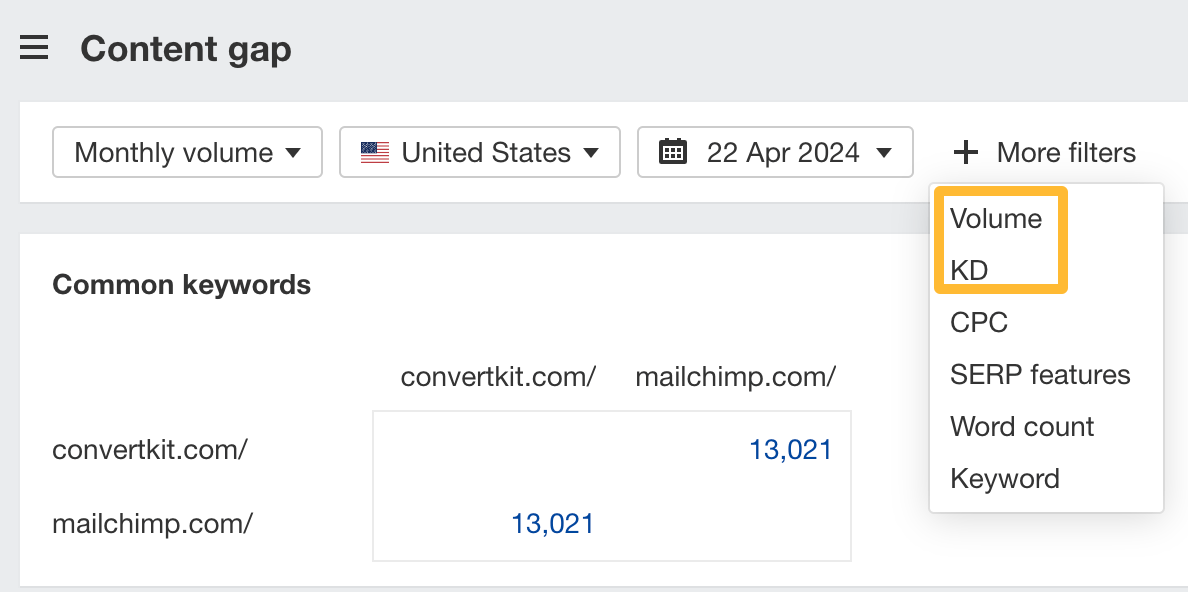

How to find keywords multiple competitors rank for, but you don’t
- Go to Competitive Analysis
- Enter your domain in the This target doesn’t rank for section
- Enter the domains of multiple competitors in the But these competitors do section
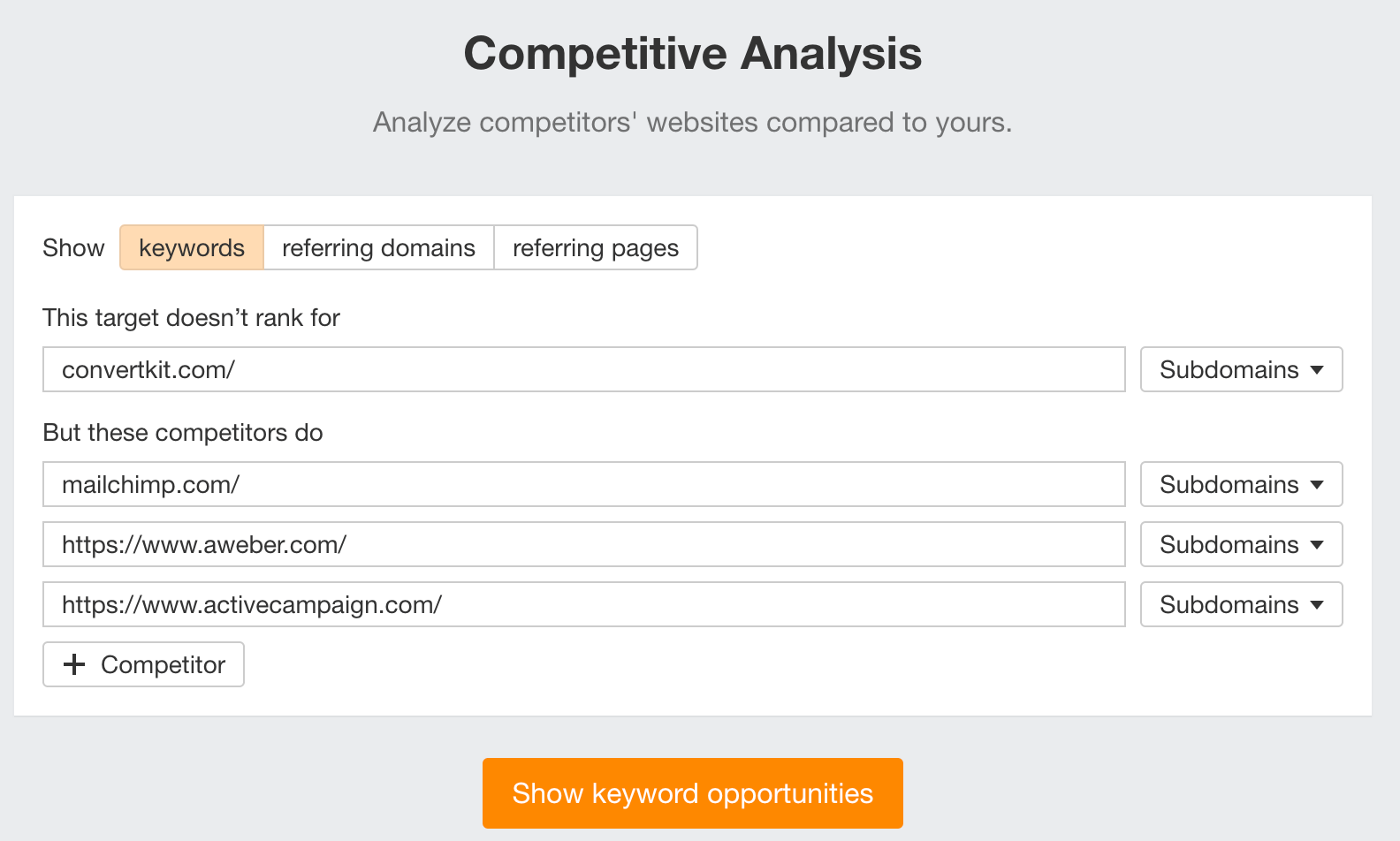

You’ll see all the keywords that at least one of these competitors ranks for, but you don’t.
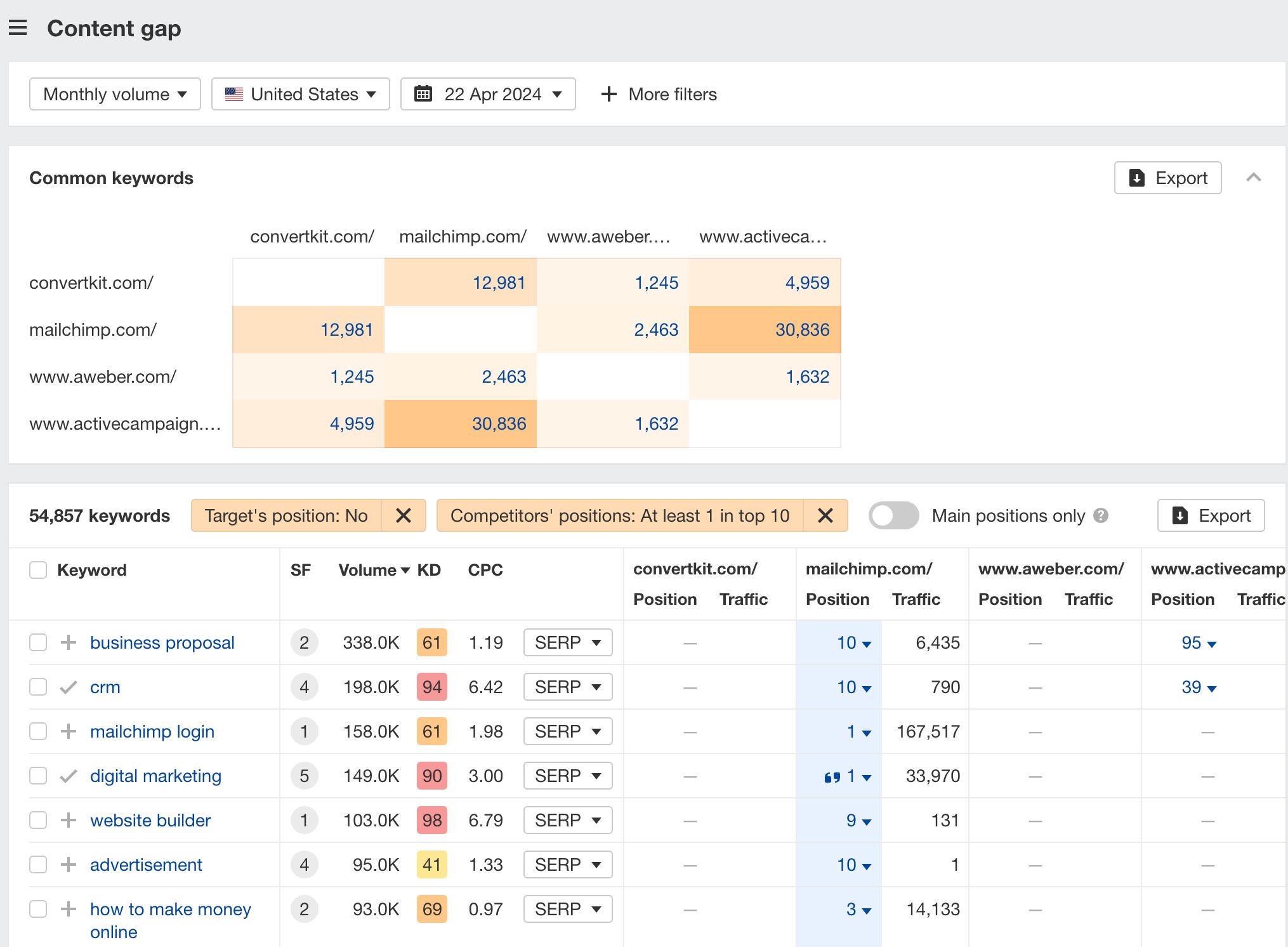

You can also narrow the list down to keywords that all competitors rank for. Click on the Competitors’ positions filter and choose All 3 competitors:
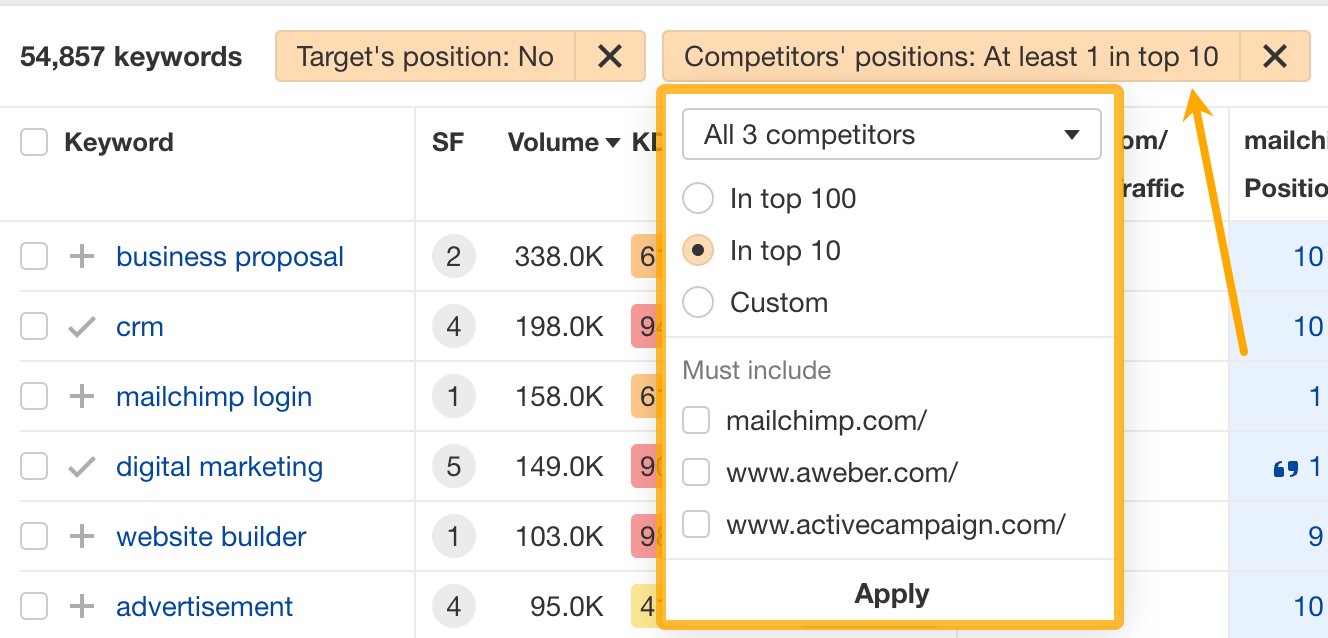

- Go to Ahrefs’ Site Explorer
- Enter your competitor’s domain
- Go to the Paid keywords report
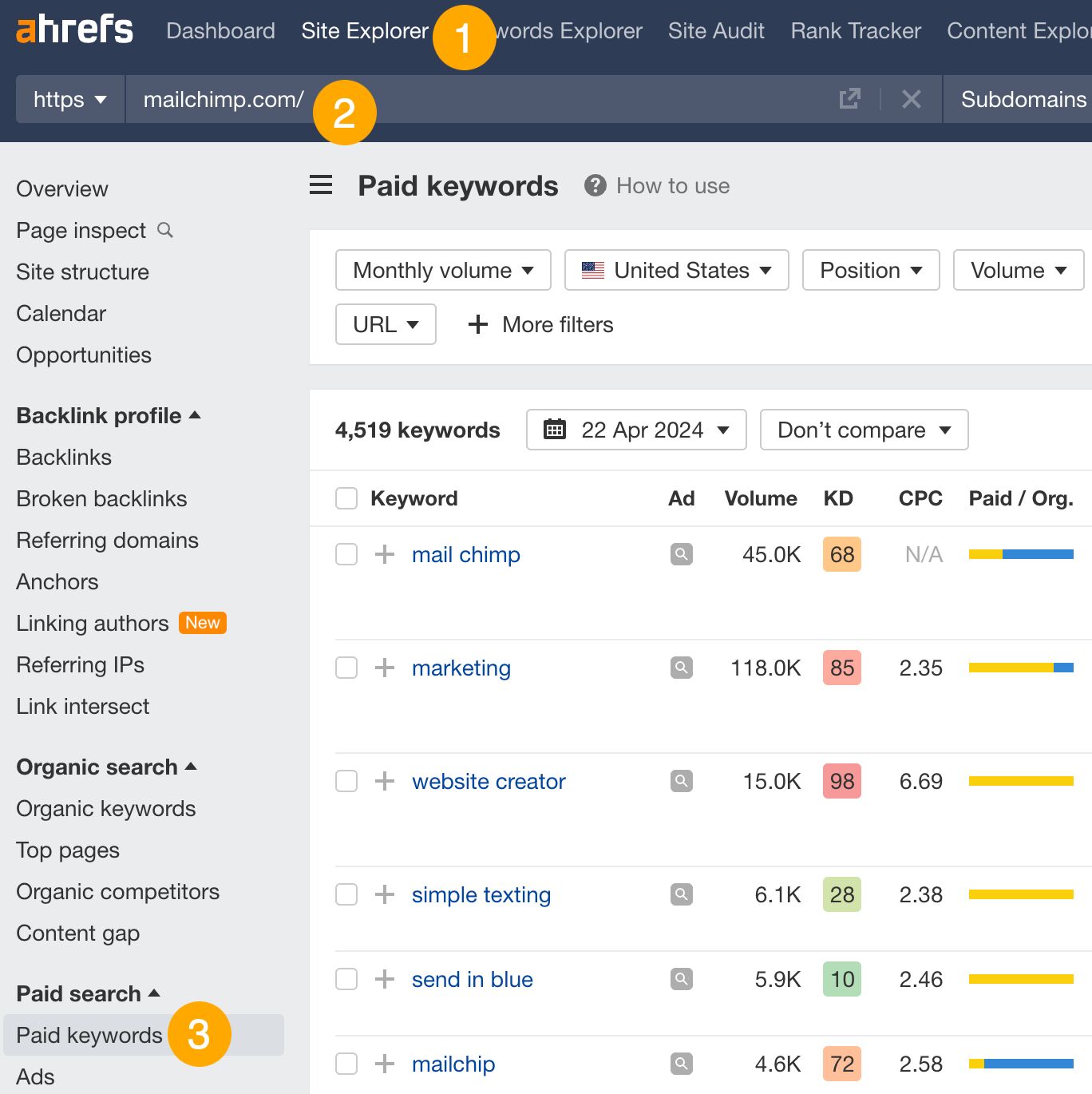

This report shows you the keywords your competitors are targeting via Google Ads.
Since your competitor is paying for traffic from these keywords, it may indicate that they’re profitable for them—and could be for you, too.
You know what keywords your competitors are ranking for or bidding on. But what do you do with them? There are basically three options.
1. Create pages to target these keywords
You can only rank for keywords if you have content about them. So, the most straightforward thing you can do for competitors’ keywords you want to rank for is to create pages to target them.
However, before you do this, it’s worth clustering your competitor’s keywords by Parent Topic. This will group keywords that mean the same or similar things so you can target them all with one page.
Here’s how to do that:
- Export your competitor’s keywords, either from the Organic Keywords or Content Gap report
- Paste them into Keywords Explorer
- Click the “Clusters by Parent Topic” tab
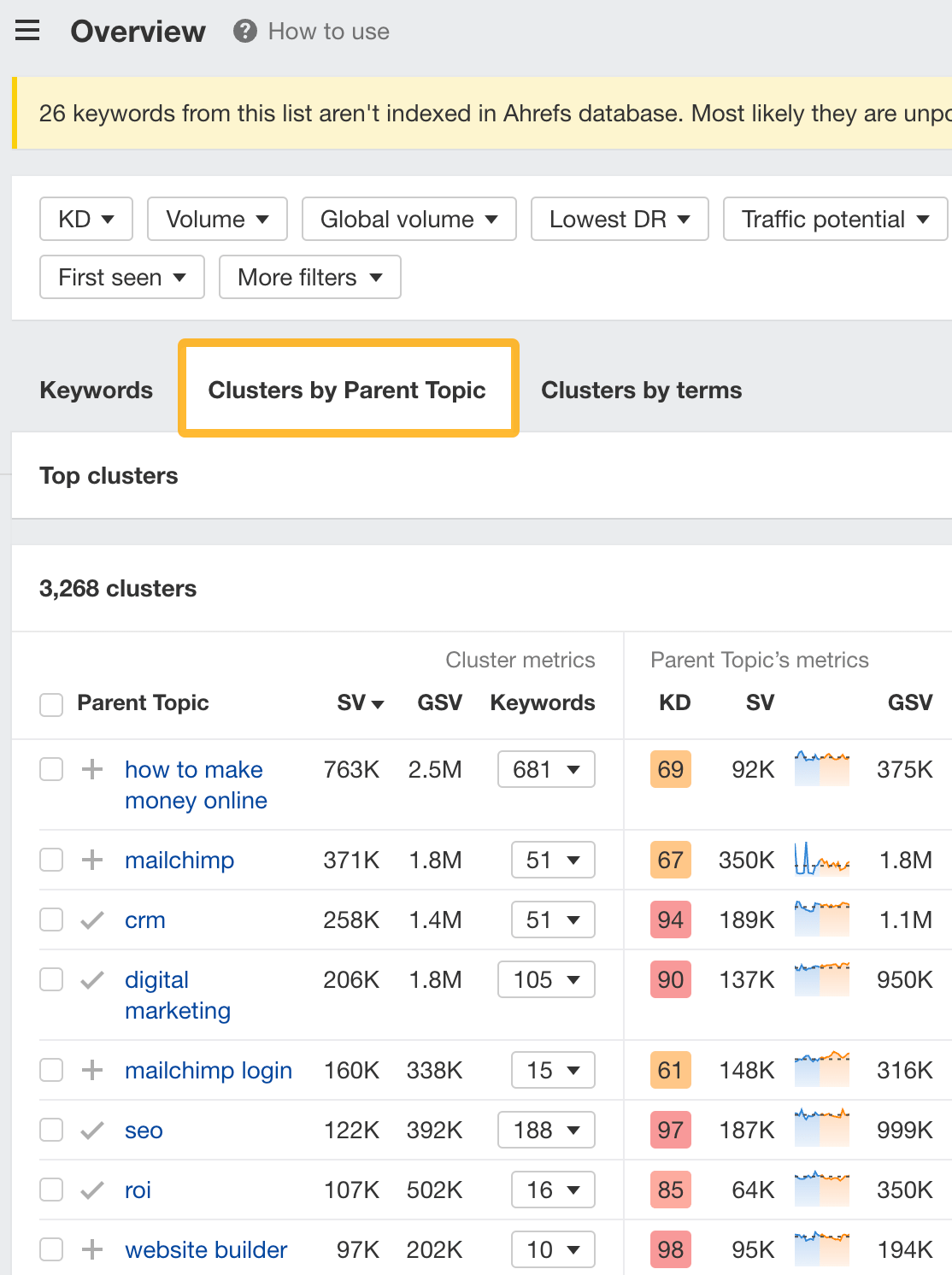

For example, MailChimp ranks for keywords like “what is digital marketing” and “digital marketing definition.” These and many others get clustered under the Parent Topic of “digital marketing” because people searching for them are all looking for the same thing: a definition of digital marketing. You only need to create one page to potentially rank for all these keywords.
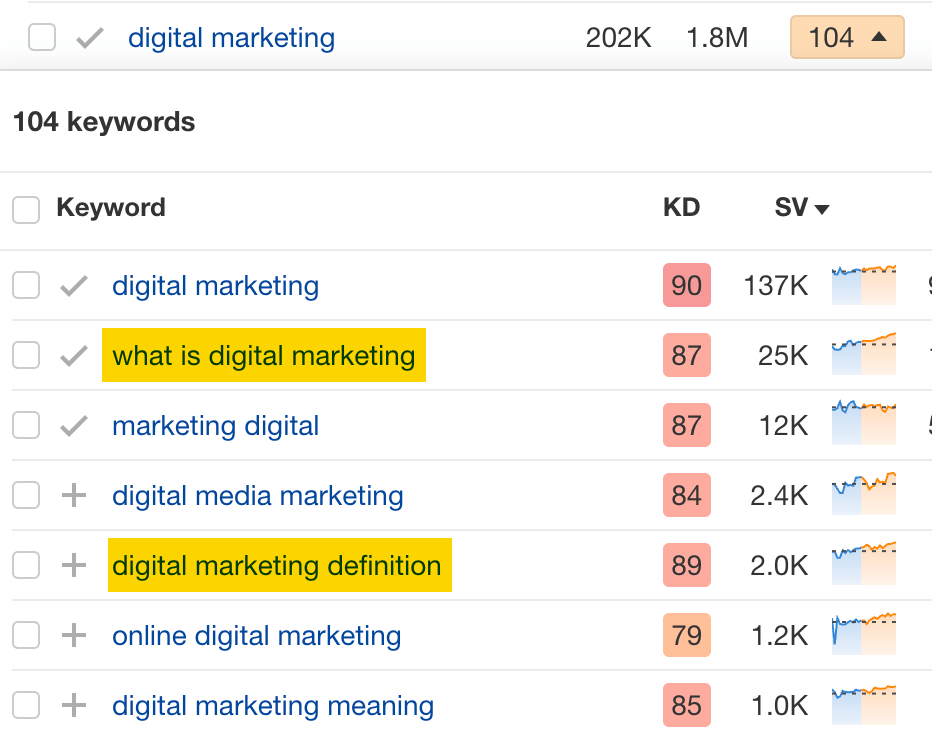

2. Optimize existing content by filling subtopics
You don’t always need to create new content to rank for competitors’ keywords. Sometimes, you can optimize the content you already have to rank for them.
How do you know which keywords you can do this for? Try this:
- Export your competitor’s keywords
- Paste them into Keywords Explorer
- Click the “Clusters by Parent Topic” tab
- Look for Parent Topics you already have content about
For example, if we analyze our competitor, we can see that seven keywords they rank for fall under the Parent Topic of “press release template.”


If we search our site, we see that we already have a page about this topic.


If we click the caret and check the keywords in the cluster, we see keywords like “press release example” and “press release format.”
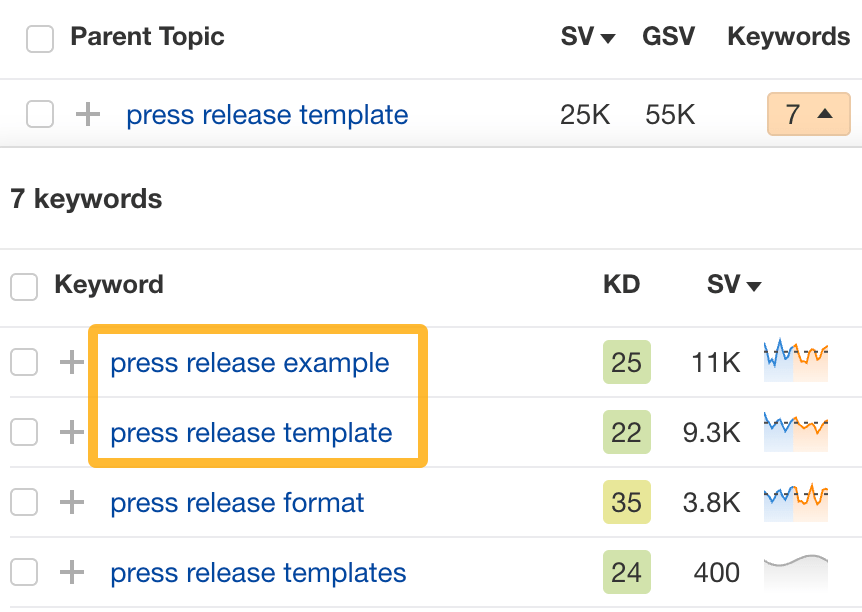

To rank for the keywords in the cluster, we can probably optimize the page we already have by adding sections about the subtopics of “press release examples” and “press release format.”
3. Target these keywords with Google Ads
Paid keywords are the simplest—look through the report and see if there are any relevant keywords you might want to target, too.
For example, Mailchimp is bidding for the keyword “how to create a newsletter.”


If you’re ConvertKit, you may also want to target this keyword since it’s relevant.
If you decide to target the same keyword via Google Ads, you can hover over the magnifying glass to see the ads your competitor is using.
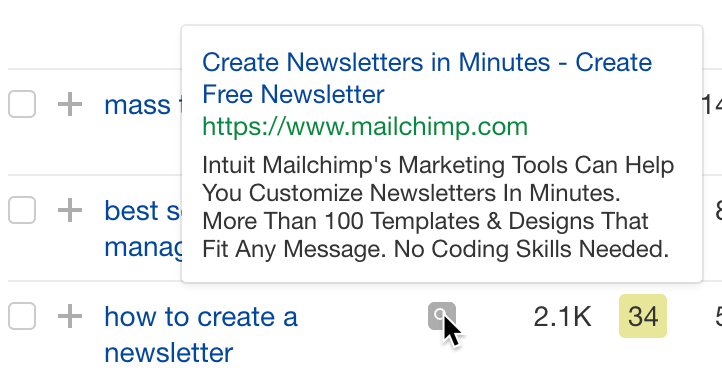

You can also see the landing page your competitor directs ad traffic to under the URL column.


Learn more
Check out more tutorials on how to do competitor keyword analysis:
SEO
Google Confirms Links Are Not That Important

Google’s Gary Illyes confirmed at a recent search marketing conference that Google needs very few links, adding to the growing body of evidence that publishers need to focus on other factors. Gary tweeted confirmation that he indeed say those words.
Background Of Links For Ranking
Links were discovered in the late 1990’s to be a good signal for search engines to use for validating how authoritative a website is and then Google discovered soon after that anchor text could be used to provide semantic signals about what a webpage was about.
One of the most important research papers was Authoritative Sources in a Hyperlinked Environment by Jon M. Kleinberg, published around 1998 (link to research paper at the end of the article). The main discovery of this research paper is that there is too many web pages and there was no objective way to filter search results for quality in order to rank web pages for a subjective idea of relevance.
The author of the research paper discovered that links could be used as an objective filter for authoritativeness.
Kleinberg wrote:
“To provide effective search methods under these conditions, one needs a way to filter, from among a huge collection of relevant pages, a small set of the most “authoritative” or ‘definitive’ ones.”
This is the most influential research paper on links because it kick-started more research on ways to use links beyond as an authority metric but as a subjective metric for relevance.
Objective is something factual. Subjective is something that’s closer to an opinion. The founders of Google discovered how to use the subjective opinions of the Internet as a relevance metric for what to rank in the search results.
What Larry Page and Sergey Brin discovered and shared in their research paper (The Anatomy of a Large-Scale Hypertextual Web Search Engine – link at end of this article) was that it was possible to harness the power of anchor text to determine the subjective opinion of relevance from actual humans. It was essentially crowdsourcing the opinions of millions of website expressed through the link structure between each webpage.
What Did Gary Illyes Say About Links In 2024?
At a recent search conference in Bulgaria, Google’s Gary Illyes made a comment about how Google doesn’t really need that many links and how Google has made links less important.
Patrick Stox tweeted about what he heard at the search conference:
” ‘We need very few links to rank pages… Over the years we’ve made links less important.’ @methode #serpconf2024″
Google’s Gary Illyes tweeted a confirmation of that statement:
“I shouldn’t have said that… I definitely shouldn’t have said that”
Why Links Matter Less
The initial state of anchor text when Google first used links for ranking purposes was absolutely non-spammy, which is why it was so useful. Hyperlinks were primarily used as a way to send traffic from one website to another website.
But by 2004 or 2005 Google was using statistical analysis to detect manipulated links, then around 2004 “powered-by” links in website footers stopped passing anchor text value, and by 2006 links close to the words “advertising” stopped passing link value, links from directories stopped passing ranking value and by 2012 Google deployed a massive link algorithm called Penguin that destroyed the rankings of likely millions of websites, many of which were using guest posting.
The link signal eventually became so bad that Google decided in 2019 to selectively use nofollow links for ranking purposes. Google’s Gary Illyes confirmed that the change to nofollow was made because of the link signal.
Google Explicitly Confirms That Links Matter Less
In 2023 Google’s Gary Illyes shared at a PubCon Austin that links were not even in the top 3 of ranking factors. Then in March 2024, coinciding with the March 2024 Core Algorithm Update, Google updated their spam policies documentation to downplay the importance of links for ranking purposes.
The documentation previously said:
“Google uses links as an important factor in determining the relevancy of web pages.”
The update to the documentation that mentioned links was updated to remove the word important.
Links are not just listed as just another factor:
“Google uses links as a factor in determining the relevancy of web pages.”
At the beginning of April Google’s John Mueller advised that there are more useful SEO activities to engage on than links.
Mueller explained:
“There are more important things for websites nowadays, and over-focusing on links will often result in you wasting your time doing things that don’t make your website better overall”
Finally, Gary Illyes explicitly said that Google needs very few links to rank webpages and confirmed it.
I shouldn’t have said that… I definitely shouldn’t have said that
— Gary 鯨理/경리 Illyes (so official, trust me) (@methode) April 19, 2024
Why Google Doesn’t Need Links
The reason why Google doesn’t need many links is likely because of the extent of AI and natural language undertanding that Google uses in their algorithms. Google must be highly confident in its algorithm to be able to explicitly say that they don’t need it.
Way back when Google implemented the nofollow into the algorithm there were many link builders who sold comment spam links who continued to lie that comment spam still worked. As someone who started link building at the very beginning of modern SEO (I was the moderator of the link building forum at the #1 SEO forum of that time), I can say with confidence that links have stopped playing much of a role in rankings beginning several years ago, which is why I stopped about five or six years ago.
Read the research papers
Authoritative Sources in a Hyperlinked Environment – Jon M. Kleinberg (PDF)
The Anatomy of a Large-Scale Hypertextual Web Search Engine
Featured Image by Shutterstock/RYO Alexandre
-

 PPC5 days ago
PPC5 days ago19 Best SEO Tools in 2024 (For Every Use Case)
-

 MARKETING7 days ago
MARKETING7 days agoStreamlining Processes for Increased Efficiency and Results
-
SEARCHENGINES6 days ago
Daily Search Forum Recap: April 17, 2024
-

 PPC7 days ago
PPC7 days ago97 Marvelous May Content Ideas for Blog Posts, Videos, & More
-

 SEO6 days ago
SEO6 days agoAn In-Depth Guide And Best Practices For Mobile SEO
-
SEARCHENGINES5 days ago
Daily Search Forum Recap: April 18, 2024
-

 MARKETING6 days ago
MARKETING6 days agoEcommerce evolution: Blurring the lines between B2B and B2C
-
SEARCHENGINES4 days ago
Daily Search Forum Recap: April 19, 2024










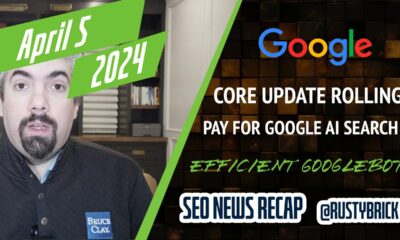





You must be logged in to post a comment Login